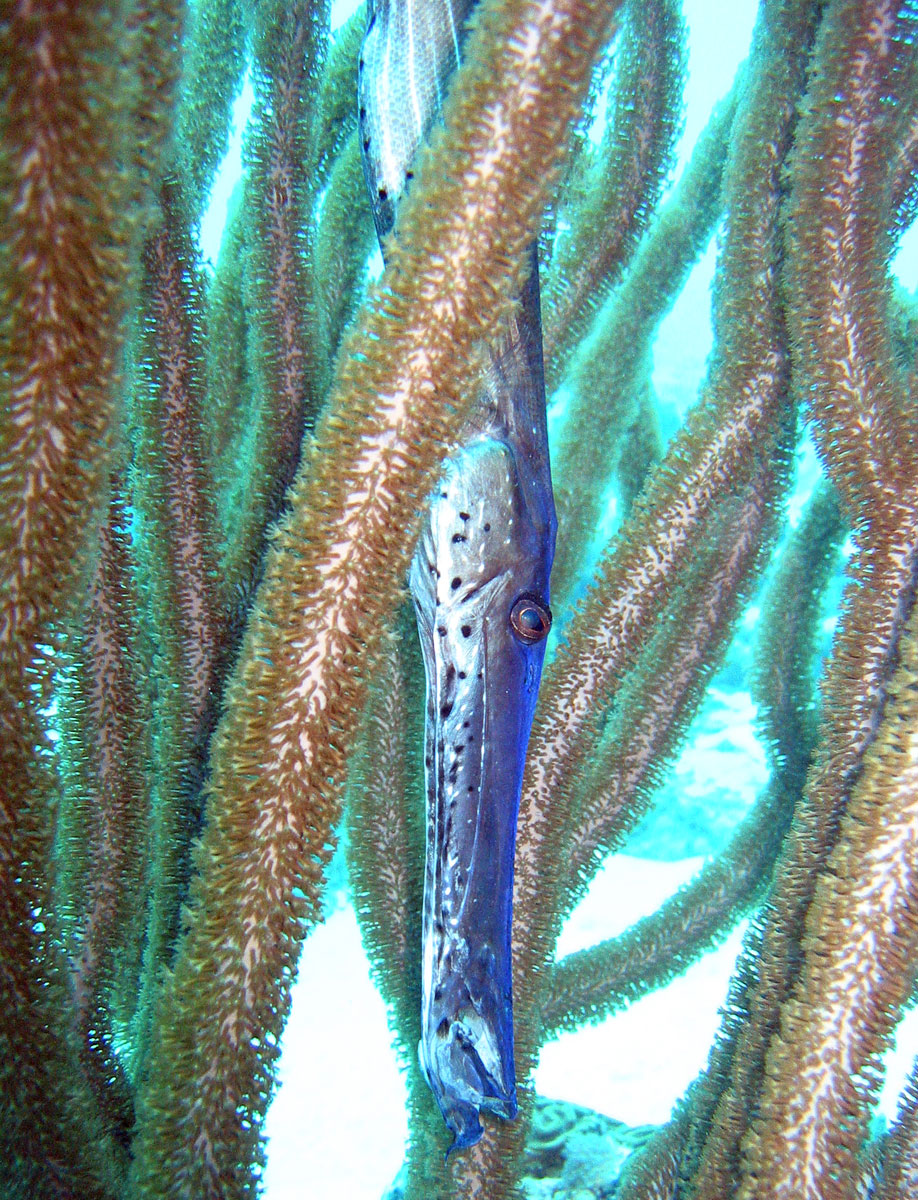- Syngnathiformes
Taxobox
name = Syngnathiformes

image_width = 200px
image_caption =Trumpetfish ("Aulostomus maculatus":Aulostomidae ), head in natural pose
regnum =Animal ia
phylum =Chordata
superclassis =Osteichthyes
classis =Actinopterygii
subclassis =Neopterygii
infraclassis =Teleostei
superordo =Acanthopterygii
ordo = Syngnathiformes
ordo_authority =Helfman ,Collette &Facey ,1997
subdivision_ranks = Families
subdivision =Aulostomidae Centriscidae Fistulariidae Pegasidae (disputed)Solenostomidae Syngnathidae
and see textSyngnathiformes is an order of
ray-finned fish es that includes thepipefish es andseahorse s.FishBase (2005)]These fishes have elongate, narrow, bodies surrounded by a series of bony rings, and small, tubular mouths. Several groups live among
seaweed and swim with the body aligned vertically, to blend in with the stems.The name "Syngnathiformes" means "conjoined-jaws". It is derived from
Ancient Greek "syn" ("συν", "together") + "gnathos" ("γνάθος", "jaw"). The ending for fish orders "-formes" is derived fromLatin and indicates "of similar form".Systematics and taxonomy
In some treatments, these fishes are placed as the
suborder Syngnathoidei of the orderGasterosteiformes together with thestickleback s and their relatives [E.g. Helfman "et al." (1997), ITIS (2004), Nelson (2006)] . Better supported by the evidence nowadays available is the traditional view [E.g. McAllister (1968)] that they are better considered separate orders, and indeed among theAcathopterygi they might be not particularly close relatives at allKawahara (2008)] .In addition, the
armoured stickleback (Indostomidae) and thePegasidae (dragonfishes and sea moths) are variously placed with the pipefish or the stickleback lineage. While the placement in Syngnathiformes seems to be correct for the latter, the former is probably still best considered an actinopterygian order of its own for the time being.Morphological traits uniting the
flying gurnard s (Dactylopteridae) and the Syngnathiformes have long been noted [Pietsch (1978)] . Most authors however placed them with theScorpaeniformes . However,DNA sequence data quite consistently supports the view that the latter areparaphyletic with the Gasterosteiformes "sensu lato". As it seems, flying gurnards are particularly close toAulostomidae andFistulariidae , and would have to be included with these.A tentative list of the families in the phylogenetic sequence can be given as follows:
*Centriscidae –razorfish es,shrimpfish es and snipefishes (including Macroramphosidae)
*Pegasidae – dragonfishes and sea moths (tentatively placed here)
*Solenostomidae – false pipefishes, ghost pipefishes and tubemouth fishes
*Syngnathidae –seahorse s and truepipefish es
*Aulostomidae – trumpetfishes
*Dactylopteridae – flying gurnards (tentatively placed here)
*Fistulariidae – cornetfishesFootnotes
References
* (2005): [http://www.fishbase.org/Summary/OrdersSummary.cfm?order=Syngnathiformes Order Summary for Syngnathiformes] . Version of 2005-FEB-15. Retrieved 2008-AUG-19.
* (2004): [http://www.itis.gov/servlet/SingleRpt/SingleRpt?search_topic=TSN&search_value=166438 Syngnathoidei (TSN 166438)] . Retrieved 2006-APR-08
* (2008): Interrelationships of the 11 gasterosteiform families (sticklebacks, pipefishes, and their relatives): A new perspective based on mitogenome sequences from 75 higher teleosts. "Mol. Phylogenet. Evol." 46(1): 224–236. doi|10.1016/j.ympev.2007.07.009 (HTML abstract)
* (1968): Evolution of branchiostegals and classification of teleostome fishes. "Bulletin of the Nattional Museum of Canada, Ottawa" 221: 1–239.
* (2006): "Fishes of the World ". John Wiley & Sons, Inc. ISBN 0471250317
* (1978): Evolutionary relationships of the sea moths (Teleostei: Pegasidae) with a classification of gasterosteiform families. "Copeia " 1978(3): 517–529. [http://www.jstor.org/pss/1443620 JPEG abstract and first page text]
Wikimedia Foundation. 2010.
